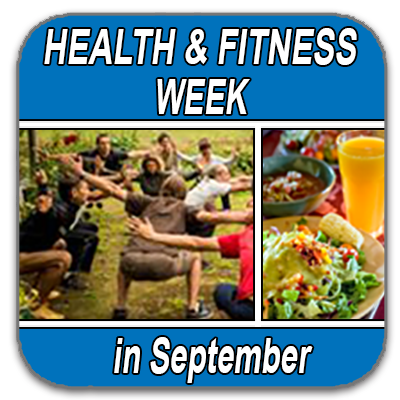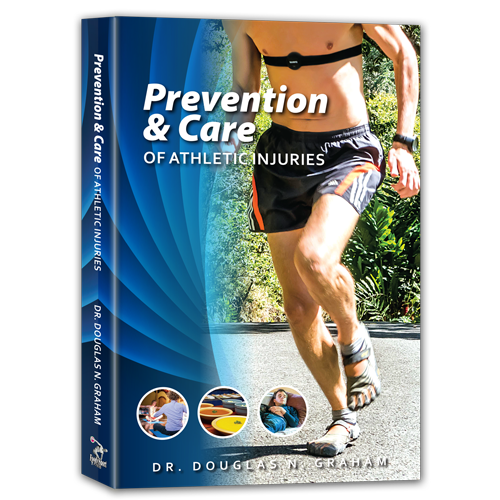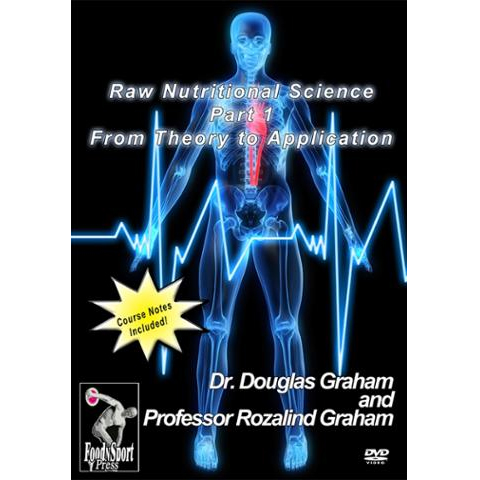Nutrition and Athletic Recovery - Part I of II
by Dr. Graham

As we mature, we may become more aware of our physical limitations. At the same time, we gain the knowledge and expertise to push those limits to the edge. For people who enjoy the physical side of life, vigorous and rigorous activities can be wonderfully pleasant. The personal growth, improvements in performance, and mental strength that develop with dedicated practice and animated play provide much satisfaction. A feeling of connectedness with others develops, both through team play and in knowing that other people worldwide also enjoy similar activities. The lessons learned in physical training — patience, persistence, goal setting, repetition, teamwork, etc. — can be applied to all facets of life. An integral part of vibrant health, physical fitness certainly carries many rewards.
Being active as regularly as we would like may prove to be a challenge, and recovery from activity is often slower than expected. The weekend warrior is not the only one at risk here. Most of us fall into a routine of activity that rarely changes. Thus, the runner who goes for a bike weekend, the soccer player who swims and surfs for the first time in years, the once-a-year skier — all are at risk of overtraining. Sore joints, stiff muscles, lethargy, acute injuries, and lack of motivation are just a few of the initial symptoms of overtraining. Increased resting heart rate, dread of exercise, and chronic aches, pains, and injuries are additional warning signs that you may be experiencing long-term overtraining.
Sports scientists, fitness trainers, athletes, and coaches have put tremendous energy into improving training techniques. Cross training, weight training, build-up and taper-down strategies, phased training, and specificity of workouts have all contributed to the perpetual crashing of all athletic records and the increased intensity of team and individual sports. The "impossible" four-minute mile is now a common event, run not just by world-class milers but also by high school boys and even men over forty.
But training harder has not always translated into training smarter. Sports injuries, both mild and severe, are at an all-time high. Burnout often hits young athletes before they ever reach their prime. Many professional sports are now dominated by teenagers, and the thirty-year-old athlete is becoming a rarity. In my opinion, the problem lies not in poor training techniques, but in the haphazard methods that most athletes apply to their recovery.
Insufficient and improper recovery skills have as much to do with athletic injury as does improper training.
Four basic deficiency factors can compromise the body's ability to recover from training. These are insufficient sugar, salt, water, and/or rest and sleep. It is important to learn how these four factors function and interact. Modifying your regimen takes work, but the advantages you gain will be well worth the effort. You will reap the healthy harvest of more speedy recovery and the ability to push your physical exertions to new and perhaps unimagined heights. Optimum recovery will also put you at less risk of injury and extend your ability to enjoy an activity-filled life.
The Role of Sugars
Every cell of the body uses simple sugars, in the form of glucose and/or fructose, to fuel energy. We store this sugar three ways: as muscle glycogen, liver glycogen, and blood sugar. Liver glycogen is mostly held in reserve as fuel for the brain. When we are active, the body first uses predominantly muscle glycogen to fuel the muscles, and little blood sugar. It takes approximately two hours of high-intensity aerobic activity (70-80% VO2 max) to use up most of our available muscle glycogen. During this period and for about an hour more, the percentage of blood sugar being used increases constantly, until finally these supplies also run dry.
Reestablishing blood sugar to normal levels and replenishing muscle glycogen supply are absolute requirements for efficient and effective recovery. We can do this most easily by consuming fruit shortly after exercising. While blood sugar rises fairly rapidly after we eat fruit, muscle glycogen supplies are slow to replenish. During exercise, and to a lesser extent for about two hours afterward, the blood is rich with the enzyme glycogenase, which doubles the body's ability to convert sugar into muscle glycogen. For this brief period, it is possible to replenish glycogen at double the normal rate, thus fostering a speedy recovery.
Eating fruit during long training sessions and directly after exercise, accelerates the replenishment of muscle glycogen, thus optimizing recovery rate.
Should the exertions be long enough or intense enough to seriously deplete supplies of muscle glycogen, it could take twenty-four hours to bring levels back to normal, even at optimal replenishment rates. If we don't take the opportunity to replenish blood sugar and muscle glycogen stores directly following exercise, forty-eight hours may elapse before they are refilled. Thus it is extremely important to supply sufficient fruit sugar before, during, and immediately after intense exercise, especially when intense or of long duration.
Bananas and dates contain the sugars and related nutrients that allow for optimum speed of sugar uptake. Blended with enough water to provide adequate rehydration (as sugars cannot be properly converted to glycogen without ample water) bananas are, perhaps, the perfect food for this aspect of recovery. Acid fruits high in sugar such as pineapples, tangerines, certain oranges, and grapefruits also provide the glucose and fructose necessary for quickly replenishing blood sugar and water needs. For this reason, bananas and oranges are provided free of charge to all participants after most running races.
The Role of Mineral Salts
Salts in the body play a vital role in virtually every function of each cell. There are at least twelve mineral salts in the body, each used for its own specialized functions. Salts take the form of electrolytes (positively and negatively charged ions) and create the osmotic pressure that fosters fluid movement through the semipermeable cell membranes. Mineral salts are responsible for the flow of nutrients into the cell and the elimination of the waste products of cell metabolism. Without the osmotic pressure, i.e., electrical potential, created by disolved mineral salts, there would be no life. Too little salt and the body ceases to function. Too much salt and we die of dehydration. It is imperative that we maintain the homeostasis of this delicate relationship.
Sodium and potassium are two of the key minerals involved in electrolyte balance. Sodium is the main extracellular mineral, while potassium is the main intracellular mineral. Nutrients "ride" into the cell on potassium. Cellular metabolic waste is carried out of the cell hitched to sodium. Too little or too much of either of these minerals in relation to the other spells trouble in terms of recovery. Although greens such as kale, Swiss chard, and beet greens provide more of both of these nutrients, celery and spinach are among the most palatable, readily accessible, and easily digestible sources of sodium. Dates, spinach, avocados, guavas, and bananas are excellent potassium-rich foods.
While you cannot live without minerals, especially sodium, too much of it is just as severe a problem as too little, though an excess is much more common. I do not recommend adding salt (sodium chloride) to any food, nor eating food that already has salt added, as a sufficient quantity is supplied in a healthful diet. When you have more sodium in your system than is required, it is slowly and inefficiently eliminated via the kidneys and, upon exertion, the sweat glands. Symptoms of too much sodium include elevated blood pressure, kidney failure, edema and concurrent weight gain, dry skin, and thirst. With the excessive perspiration that may accompany intense athletic work or recreational endeavors, sodium is lost from its extracellular compartment. Intracellular potassium is then pumped out of the cells to maintain electrolyte balance. Along with the potassium, water leaves the cells. The resulting weakness is a common symptom of heat prostration.
To maintain the body's acid/alkaline balance, alkaline minerals must neutralize the acidic byproducts of metabolism and physical activity. Chlorine, sulfur, and phosphorus, the acidic minerals, should be consumed only in relatively small amounts. Sulfur is present in the amino acids cysteine and methionine; the latter is an essential amino acid, and is found in small amounts in all fruits, vegetables, nuts, and seeds. Phosphorus is also present in all foods, but is concentrated in foods rich in protein. Chlorine is found almost exclusively in combination with sodium in the form of common table salt, a good reason to limit its use. Alkaline minerals are more abundant than acidic minerals in our natural foods, and will predominate when our caloric intake is healthfully choreographed.
Recommended Diet for Optimal Athletic Performance and Recovery
- Breakfast: Start the day with as much water as you care for. After a morning workout, consume juicy fruit of choice until satiated. Citrus, melon, pineapple, papayas, mangos, peaches, pears, and other high-water fruits fit the bill.
- Lunch: Lunch is usually consumed following another exercise period. Sweet fruits provide the most calories from carbohydrates, per bite. The unassuming yet ubiquitous banana does a great job meeting the athlete's requirements in this regard, and should be the focus of most lunch meals. Sweet fruits (e.g., bananas, figs, dates, persimmons, mammea, canistel, sapote) combine well with subacid fruits (mangos, nectarines, pears, papayas, peaches, and the like). Lettuce and/or celery combine well with all fruit.
- Dinner: The truly active individual will want to begin the evening meal with acid or subacid fruit. If you wish to limit calorie consumption, you may choose to skip the evening fruit. A large salad of lettuce, tomato, celery, and (if desired) other vegetables comprises the main course. You can also prepare and present these ingredients as salsa, soup, slaw, or in any other manner and (optionally) dress them with avocado, nuts, or seeds. If you finish the meal and still find yourself searching for something sweet, you did not eat enough fruit at the start of the meal.
Note: Athletes consuming more than 3,000 calories per day may wish to eat an extra meal per 1,000 additional calories consumed. Bananas make a most effective and satiating extra meal.
This concludes Part I of this article. In Part II, I discuss the roles of water and rest/sleep. In addition, I provide ten tips for optimum athletic recovery.
Articles:
- Nutrition and Athletic Recovery - Part II of II by Dr. Graham
- Cool Running by Dr. Graham
- Fitness: Simple Answers to Common Questions by Dr. Graham
- Celery: More Than Worth Its Salt by Dr. Graham
Retreats:

|
Self-Study Materials:

|
(DVD Video) 
|

|
Free Video:
|
|
